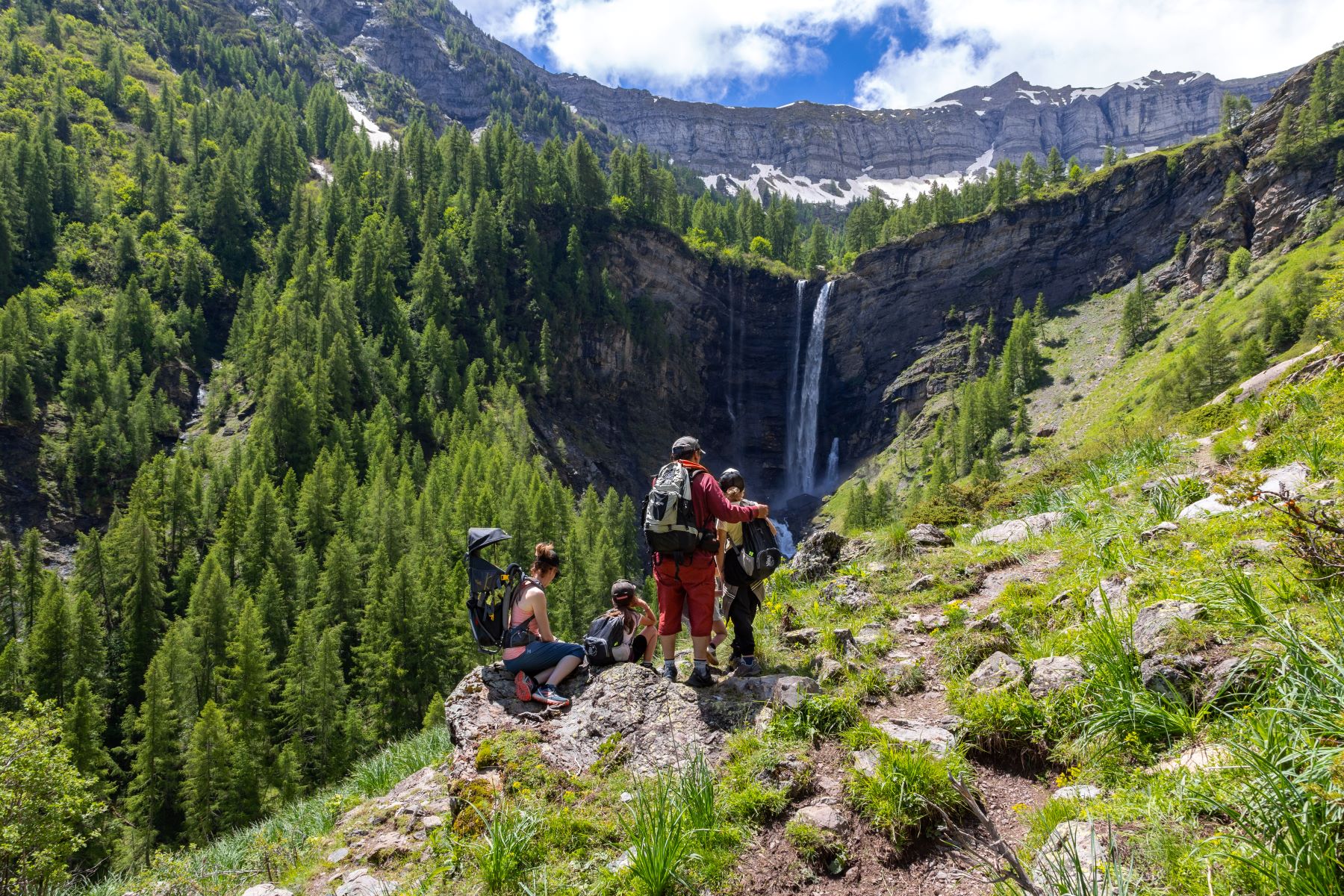
The Pisse waterfall in Champsaur
From the banks of the Drac Blanc to the Pisse waterfall, water is the guiding blue thread on this hike interlaced with trees and green pastures, showing a contrast between the north- and south-facing slopes of the valley.
Description
From the parking area, after the bridge, go up the D 472 for a few metres to the crossroads with a contemporary cross (dated 2009), then turn left up along a path that joins up with a little road leading to the village of Les Fermons. After the third bend, turn left along the path running alongside the chapel and gradually make your way up towards the Tourond refuge. The path looks down on the torrent, then gets closer to it as far as the crossroads with the route going up to Col de Venasque. Turn right into the winding path leading up to the refuge, which you will soon see above you. Below the refuge, turn left into the path that goes around the mountainside and that looks as if it is going to run up against the cliffs at the bottom of the valley. You draw closer to the waterfall, but without going right to the end of the path - for your own safety - then retrace your steps to the Tourond refuge and the start of the hike.
- Departure : Les Fermons, Champoléon
- Towns crossed : Champoléon
18 points of interest
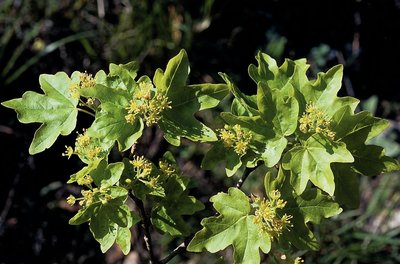
Erable champêtre avec ses samares - PNE - Nicollet Bernard  Flora
FloraField Maple
« Field » suggests cultivated plots and flowery fields, sheltered paths and tracks, work for some and a walk for others. It is a bushy little tree with leaves with five rounded lobes and maple keys whose wings indicate opposite directions. The Field Maple is not demanding concerning the humidity of the soil, it withstands the cold and drought. In difficult conditions it is just a small tree with develops cork ridges on its branches but, in rich soil, it can reach up to around twenty meters. It is also an excellent tree to place near to a bee hive since its pollen makes beautiful honey.
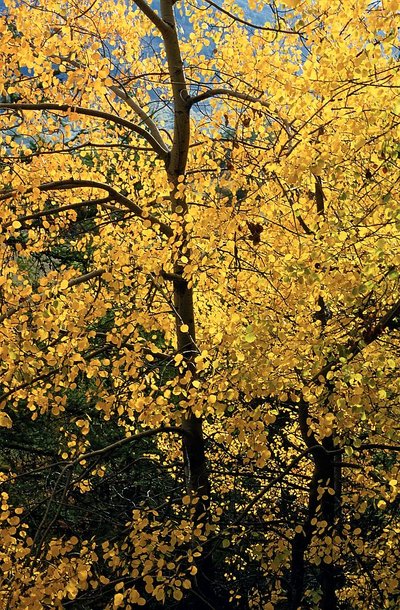
Le tremble en automne - PNE - Nicollet Bernard  Flora
FloraAspen
The leaf of the Aspen, rounded, with a winding fringe, is lashed to a long very flat petiole that makes it sensitive to the least gust of wind: a rattling of leaves can be heard in a calm moment. The trunk is slim, with a smooth grey-green bark. With age, the bark at the base thickens, cracks and darkens. Aspens are male and female. The catkins hang down, brown for males, green for females, preceding leaf growth. The Aspen takes over all the space that has not been maintained, like pastures and abandoned hayfields. Its propagation is rapid due to its capacity to multiply undergrown through numerous and intrepid shoots.
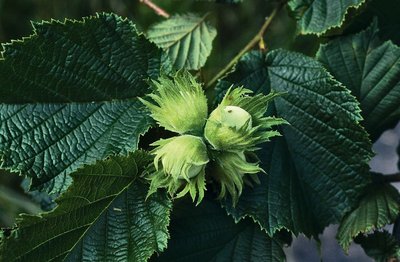
Des noisettes ... hum ! - PNE - Nicollet Bernard  Flora
FloraHazel
This bushy shrub, of 3 to 5 m in height, prospers in coppices, hedges and on fallow land at the base of the mountains... Representing fertility the hazelnut, enclosed in its shell protected by a bell-shaped herbaceous envelope is also a symbol of patience. In fact, nine months pass between the appearance of the precocious flower and the autumnal fruit. The minuscule male flowers, grouped in hanging catkins are very visible in winter, and the female flowers, squeezed in to a small brown bud topped with an elegant red puff can be found on the same branch.
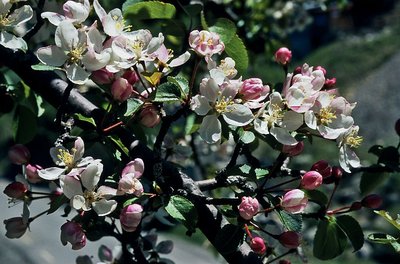
Pommier sauvage en fleur - PNE - Nicollet Bernard  Flora
FloraEuropean Crab Apple
Present everywhere and nowhere, the European Crab Apple is neither demanding nor conquering. 8 to 10 m in height, the tree has a pale grey bark and a round crown which is sometimes thorny. Unlike the domestic apple tree, its leaves, which are smaller and rounder, become perfectly hairless on both sides at the end of the season. Its pink flowers blossom in the Spring and it gives small green-yellow fruit, rarely red, with a very acidic taste.

Feuilles de frêne commun - PNE - Nicollet Jean Pierre  Flora
FloraCommon Ash
The Common Ash appreciates cool, shady places. It frequently grows beside water. But in the mountains, it is ’par excellence’, a tree found at the edge of fields. For some its name comes from the Greek word ‘phraxis’, which signifies ‘hedge’. Here, in the Tourond valley it colonizes the least well maintained slopes. Its branches positioned opposite each other have big very black buds at the end. Its flowers appear before its leaves and give ‘helicopter seeds’ which spin down in the Autumn.
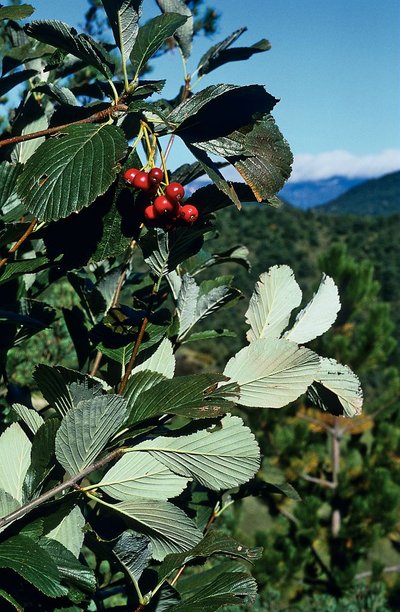
Alisier blanc et ses fruits - PNE - Nicollet Bernard  Flora
FloraWhite Beam
The White Beam can reach a height of twenty meters. Well adapted to the mountain climate, it withstands drought and big differences in temperature. In all the mountains in France, you will find them up to the subalpine level, growing as often on scree as in clearings, Its leaves present a contrast in colour and texture between the upper and lower surfaces: while the upper part is dark green, smooth and shiny, the underneath is covered with dense short hairs, the colour or snow, which gives the tree the name of White Beam. Its leaves are sometimes divided at the ends.
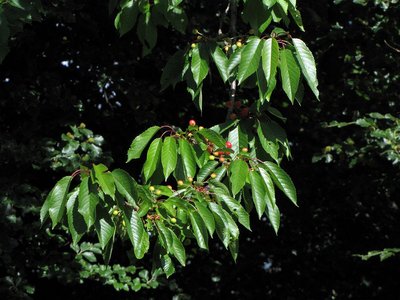
Merisier en fruits - PNE - Albert Christophe  Flora
FloraSweet Cherry
Here we are between shade and light facing the Sweet Cherry, a beautiful tree, very common here the very straight bole can reach 20 to 25 m in height. It is also called the ‘Birds’ Cherry’ because of the success of its little red and sweet fruits with our feathered friends. It is happy anywhere that it can put down its roots into deep water retaining soil especially at the edge of the forest and in hedges. Its big oval, serrated leaves are brightly coloured in Spring, turning from bronze to dark green, then yellow followed by red in Autumn. Its satiny bark should be closely observed: you will discover fine red, horizontal bands which are a sign of its precious wood, still much used by musical instrument makers, cabinet makers and wood workers when it has grown in favourable conditions.
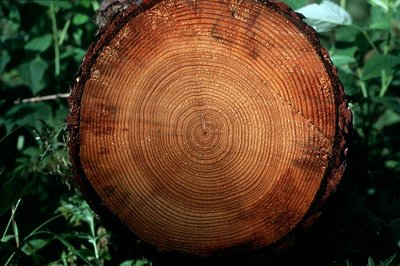
Coupe d'un mélèze : cernes de croissance - PNE - Nicollet Jean Pierre  Flora
FloraEuropean Larch
Endowed with a beautiful palette of colours, changing through the seasons, the Larch has been described at the tree of light. From Spring onwards, coloured light green, it invites you to touch it since its needles are so soft. Its branches are covered with female raspberry coloured catkins and male catkins that are a discreet yellow colour. An Autumn colour chart, it amazes us with its rich golden colours, but when Winter arrives, deprived of its needles, it has a dried up dead appearance. The larch, with its red-brown wood that is rich in amber resin is the only deciduous conifer that attacks the mountain peaks.
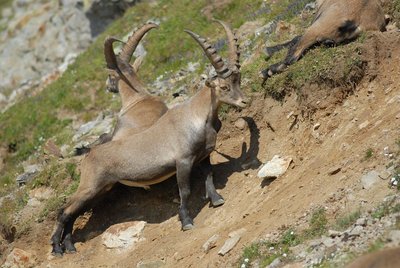
Bouquetins en pelage d'été - PNE - Papet Rodolphe  Fauna
FaunaIbex in the Summer
The males form groups and explore the massif in search of new territories. At the beginning of summer, the etagnes (females) give birth to a kid on the grassy, rocky ledges of the massif. Then, they regroup into nurseries on the high slopes.
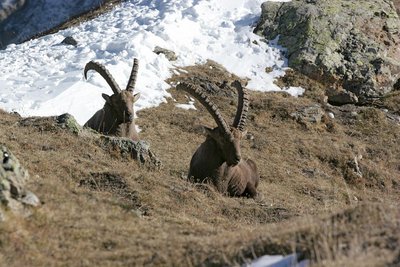
Bouquetins mâles en automne - PNE - Chevalier Robert  Fauna
FaunaIbex in the Autumn
The first Autumn snows bring the Ibex back slowly, nicknamed the "rock goats", towards the wintering areas, generally on the big rocky South facing slopes. Their coat varies in colour from chocolate to beige depending on the season and the sex. Males and females both have ringed horns that grow throughout their lives.
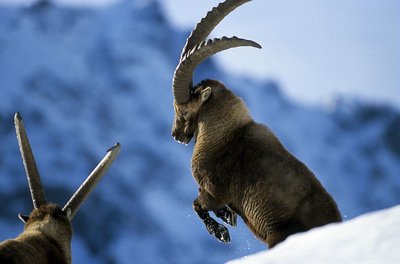
Le rut du Bouquetin en hiver - PNE - Chevallier Robert  Fauna
FaunaIbex in Winter
In Winter, the female and the male come together during the annual mating season to insure the perreniality of the species. The ridges and the craggy ledges accommodate the herds. Since the dry grass is less nourishing than in the Spring, the Ibex takes more time to feed. It can lose a third of its body weight during winter and only survives thanks to its supply of fat accumulated during the summer. It spends as much time moving around as in summer but spends more time feeding with less time to rest.
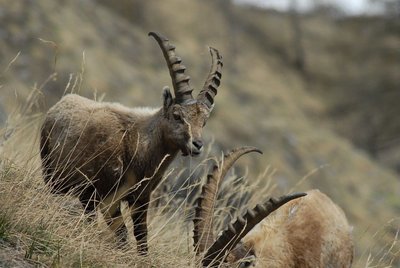
Jeunes bouquetins au printemps - PNE - Rodolphe Papet  Fauna
FaunaIbex in Spring
In Spring, the new grass brings the Ibex back to the lower pastures and the meadows in the bottom of the valley, near to the wintering area. The male herds form and jousting for social position takes place. It is at this season, that it is easiest to see them. So as not to disturb them, keep your distance from the Ibex as soon as they lift their heads to observe you. This behaviour enables us to understand that they are disturbed by our presence.
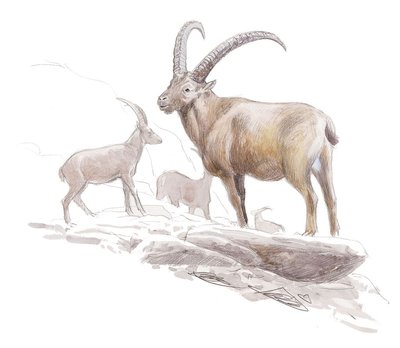
Une aquarelle pour suspendre le temps... - PNE - Dequest Pierre-Emmanuel  Fauna
FaunaThe Ibex, a surviving species
In the face of danger, the Ibex does not run away: it shelters by the rock wall where it thinks that it is safe. This strategy has enabled it to escape terrestrial predators for millennia. However, it was not proved to be effective against mankind after the invention of the crossbow and the shotgun. As a result, the Ibex almost disappeared in the 19th century. The species owes its survival to the protection put in place by Italy who created a royal reserve which later became the Grand Paradis National Park which sheltered the last population of Ibex in the Alps.
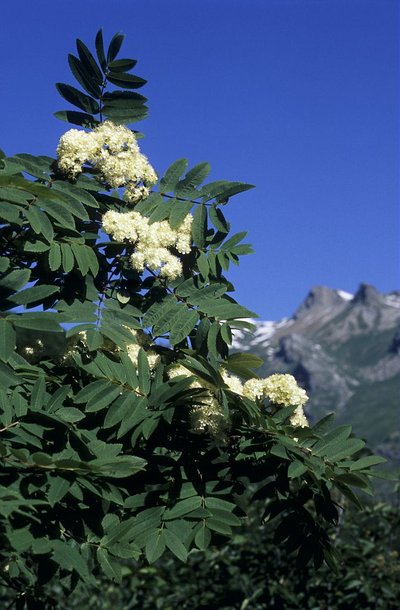
Sorbier des oiseleurs en fleur - PNE - Nicollet Bernard  Flora
FloraMountain Ash
The pennaceous leaves with serrated leaflets of the Mountain Ash wave gently in the breeze playing with the rays of the sun in this bright wood of mixed species. The bright red berries on high bushes add a touch of colour to this fresh and relaxing autumnal atmosphere. This tree which can reach a height of 20 m is quite common throughout in Sicily and the polar circle. In the Ecrins, the Mountain Ash flourishes particularly on the shadier slopes. In the Southern Alps this species can be confused with the True Service Tree, which likes higher temperatures, has hairless sticky buds and brown solid pear shaped fruits.
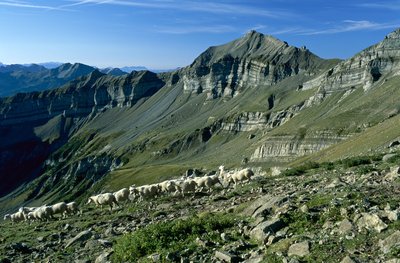
Troupeau de moutons au dessus du Tourrond - PNE - Jean Pierre Nicollet  Pastoralism
PastoralismA storage space
Up until the beginning of the last century, people and animals from the valley came to pass the summer in the village of Tourond. The sheep ate the fresh grass in the pastures right up to the pockets of snow. Around the refuge, the old piles of stones reflect the memory of intense agricultural activity. Some stacks of stones create borders around the plots of hayfields in order to protect them from the sheep. The chalet was given over to stocking they hay harvested around the chalets.
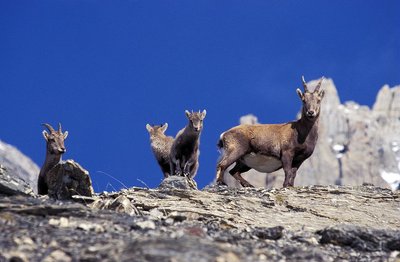
Etagnes et cabris... l'avenir du Bouquetin ! - PNE - Marc Corail  Fauna
FaunaReintroduction of the Ibex
At the end of the 19th century, the Ibex was saved at the last minute from extinction. In the Écrins massif, four reintroductions took place; the first in 1959 in the Combeynot. In 1977 a badly prepared reintroduction failed in Embrunais, in contrast to that in 1989-1990 in the Valbonnais. In 1994 and 1995, thirty individuals taken from the Vanoise National Park were introduced to the Champoléon valley. Since then, the three population sites have become established and are gradually populating the vallies.
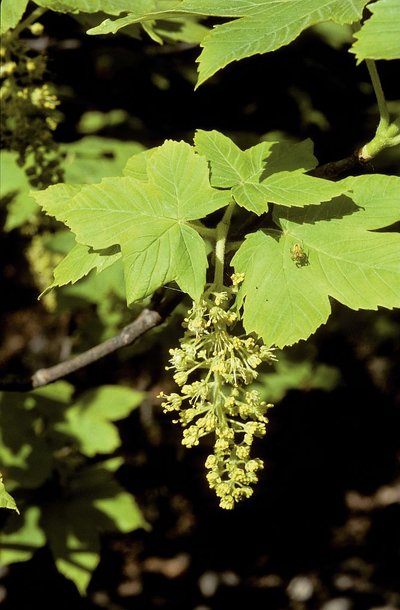
Feuilles d'erable sycomore - PNE - Nicollet Bernard  Flora
FloraSycamore Maple
Mountain species with deep roots, the Sycamore Maple likes to accompany Beech and Fir trees that are reaching for the summits. On the Northern slope, it forms, with the Mountain Elm and the large leaved Lime tree a Maple forest on the scree. This big tree, that can reach a height of 30 m, looks rather like a plane tree because of its bark and the cut of its leaves with five pointed lobes. But it can be easily identified by its ramifications that are positioned opposite each other, by the form of its fruit and ‘helicopter’ seeds. In the Spring, its precocious foliage distinguishes it from other trees which are still in the torpor of winter.

Diego, le bouquetin - Suivi par géolocalisation - PNE - Papet Rodolphe  Fauna
FaunaIbex monitoring
In 2013, a big capture operation to mark and equip Ibex with GPS collars was put in place in the Champsaur, the Valbonnais and Oisans. For duration of 3 years, these GPS collars will allow several recordings of location per day and the daily transmission of data by a satellite system. The data collection will enable us to better understand the movements of the animals in order to carry out sanitary checks on the populations that have been reintroduced to the National Park.
Forecast
Altimetric profile
Recommandations
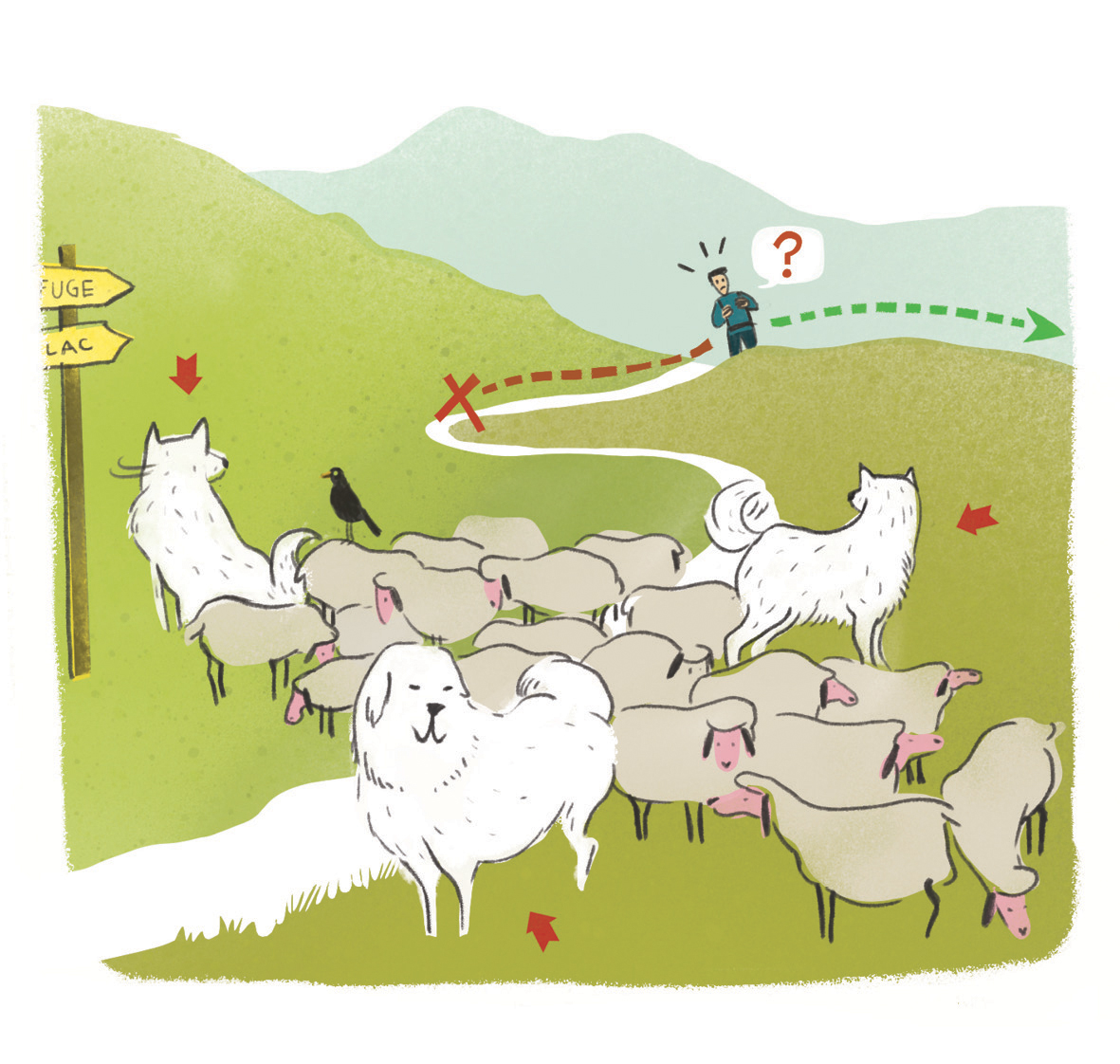 In mountain pastures, protection dogs are there to protect the herds from predators (wolves, etc.).
In mountain pastures, protection dogs are there to protect the herds from predators (wolves, etc.).
When I hike I adapt my behavior by going around the herd and pausing for the dog to identify me.
Find out more about the actions to adopt with the article "Protection dogs: a context and actions to adopt".
Tell us about your meeting by answering this survey.
Information desks
Shepherd's house
Les Borels, 05260 Champoléon
Located in the valley of Champoléon this interpretation center alpine pastoral cultures present life around a shepherd. An exhibition, educational activities, training, actions for the profession of shepherd and many other things to discover. Duration of the visit about 1:30.
Transport
Coach stop: Les Fermons
Access and parking
3 km from the Chabottes plain along the D944, cross Pont-du-Fossé, then at a crossroads after the Corbières bridge, turn left onto the D944A in the Champoléon valley. Lastly, turn left towards "Les Fermons" and park in the car park just after the bridge over the Drac Blanc.
Parking :
Source

Report a problem or an error
If you have found an error on this page or if you have noticed any problems during your hike, please report them to us here:


